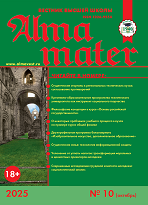UDC 330.3"192"
https://doi.org/10.20339/AM.06-21.117
N.V. Kartamysheva is Cand. Sci. (History), Ass. Prof. e-mail: kartamyshena_1@mail.ru ; and E.V. Dolzhenkova is Cand. Sci. (History), Ass. Prof. e-mail: katushenka88@ya.ru Both at South-West State University, Kursk City. Department of Theory and History of State and Law
Examined is the historical experience of our country, which in the difficult post-war years took the path of transformations and reforms, later they became an impetus for progress and development. The aim of the article is to identify the reasons, conditions, results and results of economic transformations during the NEP period. Highlighted are the main areas of activity of the Soviet state in the framework of economic reforms during the NEP period. In the process of writing the article, the historical-theoretical method was used. In addition, general scientific methods were applied, i.e. analysis, synthesis, comparison, generalization, the method of an integrated approach and others. This article analyzed the economic reforms carried out by the Soviet state during the New Economic Policy and summed up the results of these reforms. In addition, the factors influencing economic transformations were identified, and the successes and failures that the Bolshevik authorities had to face on the path of economic reforms during the NEP were considered. The authors conclusion is made, that the results of the New Economic Policy include the emergence of financially independent enterprises, overcoming the state budget deficit, the formation of the ruble as a hard convertible currency and the formation of the Soviet credit system. At the same time, the NEP was characterized by the rejection of the harsh methods of war communism and attempts to establish market relations. However, the bureaucratic leadership, which did not accept this relationship, remained.
Key words: New economic policy, economic transformations, price scissors, market, reforms, state, finance.
References
1. Orlov, I.B. New economic policy: history, experience of the problem. Moscow, 1998. 193 p.
2. The replacement of food and raw natural surplus tax: decree of the Central Executive Committee on March 21, 1921. In: Collection of laws of the RSFSR. 1921. No. 26. P. 147.
3. Golotik, S.I ., Danilin, A.B., Evseev, E.N., Karpenko, S.V. Soviet Russia in the 20s: the NEP, the power of the Bolsheviks and society. The New historical Bulletin. 2000. No. 2. P. 122–181.
4. Khrushchev, E.G. State policy in industry during the NEP period. In: Values and norms of legal culture: collection of scientific articles of the VI International Round table dedicated to the birthday of I.A. Ilyin, Russian philosopher and lawyer. Kursk, 2016. P. 349–354.
5. Fatyanov, Ya.I. NEP: basic transformations and results. Economics and Business: theory and practice. 2018. No. 7. P. 125–128.
6. Orlov, I.B. State industrial policy in the 1920s: anti-crisis or crisis model? Russian Regions: a look into the future. 2015. No. 1. P. 1–32.
7. Kartamysheva, N.V., Bryantsev, N.A. Attracting foreign capital to the Soviet economy in the twenties of the twentieth century: lessons learned. Izvestiya Yugo-Zapadnogo gosudarstvennogo universiteta. Series: History and Law. 2017. No. 4 (25). P. 175–180.
8. Yanin, M. New features in conservative policy. Planned economy. 1925. No. 7. P. 39–53.
9. Repinetsky, A.I. Nepmany — “new Russians of the 1920s”. Otechestvennaya istoriya. 2009. No. 6. P. 133–138.
10. On the basic private property rights recognized by the RSFSR, protected by its laws and protected by the courts of the RSFSR: decree of the Central Executive Committee of May 22, 1922. Collection of laws of the RSFSR. 1922. No. 36, Art. 423.
11. Sokolnikov, G.Ya. Monetary reform (1925) — financial recovery of the economy. Experience of NEP. Moscow, 1990. 218 p.
12. Larina, O.G. Category of financial prerogatives of the state in historical and legal science. Izvestiya Yugo-Zapadnogo gosudarstvennogo universiteta. 2010. No. 2 (31). P. 128–132.
13. Kartamysheva, N.V., Khudo, V.D. Achievements and miscalculations of financial and economic transformations during the NEP period. Izvestiya Yugo-Zapadnogo gosudarstvennogo universiteta. Series: History and Law. 2016. No. 4 (21). P. 175–180.
14. Gimpelson, E.G. Nep. The New Economic Policy of Lenin and Stalin. Problems and lessons (20s of the XX century). Moscow: Sobranie, 2004. 303 p.
15. Bukharin, N.I. Report “Report of the representative of the RCP (b) in the Executive Committee of the Comintern”, dated May 27, 1924. URL: http://www.agitclub.ru/front/com/part151.htm. (accessed on: 19.03.2021).











.png)






